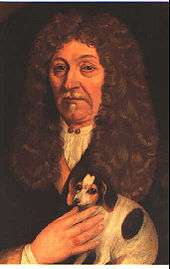Henry Bishop (postmaster general)

Henry Bishopp, (1611–1691/2), also spelt Bishop and Bisshopp, from Henfield in Sussex, England was a Postmaster General of England and inventor of the first postmark used on mail. He was the second son of Sir Thomas Bishopp, 1st Baronet of Parham in Sussex.[1] Henry at first fought for King Charles I, but was reconciled with parliament in 1647, after spending two years in Virginia. In the meantime his Rectory estate in Henfield had been sequestered. However, he was restored to royal favour in 1660 and served as postmaster-general between that date and 1663. At his death in 1692 his Rectory estate in Henfield passed to his great-nephew Sir Cecil Bishopp, 4th Baronet.[1]
Postmaster General
Before the creation of the position of Postmaster General, control of the post was in the hands of "Master of the King's Post". In 1660, at The Restoration, Henry Bishop paid £21,500 per year to farm the Post Office[2] for a term of seven years. This was more than double the previous payment.[3] Bishop's letters patent gave him the monopoly to carry letters within the kingdom. His appointment was to start on 25 June 1660, but was delayed until 29 September when the Act of Parliament reconstituted the General Post Office.[3] Bishop claimed no less than £500 in compensation for the loss of income because several independent posts had been started between London and the country but were not suppressed until the act was passed; they infringed on his monopoly to carry letters.[3]
Bishop was the first officially appointed Postmaster General to Charles II[4] but within a year of taking office he was accused of abuses. In reply, he mentions the improvements he instigated including the stamping of letters, on 2 August 1661.[2] He served in the position until April 1663[5] at which time he gave up the remainder of his lease to Daniel O'Neill.[3]
Bishop mark

Henry Bishop introduced the world's first known postmark that takes his name in 1661.[6] The "Bishop Mark" was designed to show the date on which a letter was received by the post and to ensure that the dispatch of letters would not be delayed. These were the world's first handstruck postage stamps[7][8]
Bishop announced,
| “ | A stamp is invented that is putt upon every letter shewing the day of the moneth that every letter comes to the office, so that no Letter Carryer may dare detayne a letter from post to post; which before was usual.[2][9] | ” |
The postmarks were usually on the back of the letter and are known initially used in the Chief Office in London[2] but were introduced later in Dublin, Edinburgh and New York City.[10]
The original London Bishop Mark, first used 19 April 1661[11][12] consisted of a small circle of 13 mm diameter, bisected horizontally, with the month (in serifed lettering) abbreviated to two letters, in the upper half and the day of the month in the lower half.[5] Similar marks were used later in Scotland and Ireland, as well as the North American colonies.[13][14]
In 1673, a new mark was brought into use which had a diameter of between 13 and 14 mm. The type used from this point was sans-serif and this continued in use until 1713. In 1713, larger handstamps were introduced which ranged in size from 14 to 20 mm. The layout of these was also changed, with the month appearing at the base. This type remained in use until 1787, when it was replaced by the double circle type.
| Political offices | ||
|---|---|---|
| Preceded by New creation |
Postmaster General 1660–1663 |
Succeeded by Daniel O'Neill |
References
- Notes
- 1 2 'Henfield: Manors and other estates', A History of the County of Sussex: Volume 6 Part 3: Bramber Rape (North-Eastern Part) including Crawley New Town (1987), pp. 140-145.
- 1 2 3 4 Hendy (1905), pp. 3–4
- 1 2 3 4 Joyce (1893), pp. 33–34
- ↑ "1500: The Reformation - From King's Post to Post Office". History of the Post. Bath Postal Museum. Retrieved 2008-11-20.
- 1 2 Shanahan, Eunice. "Bishop Marks". Eunice Shanahan. Retrieved 2008-12-11.
- ↑ Miller, Rick (2004-02-23). "World postmark primer: how to decipher dates". Refresher Course. Linn's Stamp News. Retrieved 2009-02-22.
- ↑ Lowe, Robson (1952). The Encyclopaedia of British Empire Postage Stamps, 1661-1951, vol.I. London: Robson Lowe Ltd. p. 17.
- ↑ The story of the Bishop Marks is traced in Robson Lowe, Handstruck Stamps of the Empire, (1939), Appendix 2.
- ↑ Sutton, Richard John; Kenneth W Anthony (1966). The Stamp Collector's Encyclopaedia, 6th ed. rev. New York: [New York] Philosophical Library. ISBN 0-517-08024-9.
- ↑ Feldman, David; Kane, William (1975). Handbook of Irish postal History to 1840. Dublin: David Feldman Ltd. pp. pps. 6–10. ISBN 0-9502619-1-2.
- ↑ Allan Oliver, Bishop Marks The earliest known examples of use are in the Public Records Office, Kew, West London,
- ↑ Cavendish Auctions, The Barry Jay FRPS Collection of British Postal History, 1534 - 1867, Sale 585 (June 16, 2000), description of Lot 2035
- ↑ Lowe, Robson. "The American Colonial Post Offices." The Philatelist 9, no. 4 (January 1943): 62-4.
- ↑ The colonial Bishop Marks did not have the bisecting line, and they appeared in various colours. Cf. Robson Lowe, The Encyclopaedia of British Empire Postage Stamps, 1639-1952, vol. V, pp. 23, 29, 57-8 (1973)
- Sources
- Hemmeon, Joseph Clarence (1912). The History of the British Post Office. Cambridge, MA: Harvard University. p. 261.
- Hendy, John G. (1905). The history of the early postmarks of the British Isles from their Introduction down to 1840. London: L. Upcott Gill. p. 204.
- Joyce, Herbert (1893). The History of the Post Office from its establishment down to 1836. London: Richard Bentley & Son. pp. pps. 460.